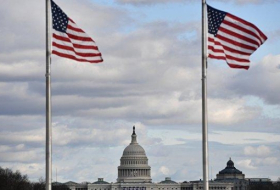As an expected one billion people take part in Earth Day, Jocelyn Timperley and Martha Henriques delve into the evidence behind protest as a force for change.
A billion people are expected to participate in some way on Saturday for this year's Earth Day.
Taking place 53 years after the first Earth Day, the global event has a theme this year of "invest in our planet" which focuses on expanding the green economy.
The large-scale rallies around the world will bring people together under a broad banner – from seasoned activists to first-time joiners.
But this Earth Day also comes after a year of disruptive direct actions from campaign groups such as Just Stop Oil which have made global headlines, from throwing soup at invaluable works of art to this week disrupting the World Snooker Championship by covering the table in orange powder.
So what impact do climate rallies and disruptive protests really have on climate action – and are the more disruptive tactics actually working?
The means and the ends
Polls have shown huge numbers of people around the world view climate change as a major threat.
In the US, some 69% of people support the country becoming carbon neutral by 2050, and over half of people consider climate a major threat to the country, although they also see solving it as lower priority than strengthening the economy, reducing health care costs or defending against terrorism.
Meanwhile, a UK poll last year by the Office of National Statistics found 74% of adults surveyed reported feeling very or somewhat worried about climate change, while an Ipsos survey found a majority of people continue to support most net zero policies.
However, concern for climate change or support for policies to address it doesn't necessarily mean support for climate protests – especially those targeted to be deliberately disruptive or provocative.
Four ways to reduce your footprint
Recent acts of disruptive civil disobedience – such as the snooker and painting protests – have stirred up strong opinions on all sides. But some groups are actively moving away from these tactics. In January, Extinction Rebellion announced its "controversial resolution to temporarily shift away from public disruption as a primary tactic", with plans to "prioritise attendance over arrest and relationships over roadblocks". Its new strategy includes plans to get 100,000 people to surround the Houses of Parliament over Earth Day weekend.
The activist's dilemma
When it comes to views on direct action, context matters. A poll conducted by Omnisis last year found 66% of people in the UK support taking non-violent direct action to protect the country's nature, for example, but another recent YouGov poll found that six in 10 Brits think defacing of art or public monuments should be made a specific criminal offence.
However, some researchers argue radical tactics deployed by small numbers of climate activists may be a good thing for wider progress – even if they are widely disliked by the public.
Often these conversations discuss the impact of the so-called "radical flank" of a movement – defined in the social sciences as activists who are taking more extreme tactics, explains Dana Fisher, a sociologist at the University of Maryland in the US who has studied climate and other types of protest for decades. The radical flank aims to pull the conversation over in terms of both solutions and the generally accepted tactics, she says.
In a piece last year in The Conversation, Heather Alberro, a lecturer in global sustainable development at Nottingham Trent University in the UK, argued disruptive protests by the radical flank can "render the demands of mainstream counterparts more palatable in the eyes of governments and the public, effectively advancing the entire movement's agenda".
Fisher also notes that dislike of the protestors themselves or their tactics doesn't appear to result in less support for climate action. In fact, it tends to do what people using these "disruption as shock" tactics want it to do, she says – pulls the conversation towards where they want it to go and even generates more support for the issue. "Most of the research shows that when people do disruption, the general public's opinion… is that they don't like the organisations or the tactics, but it does not change opinions about the policy or climate change."
Political persuasion
When you take a more fine-grained look, though, it emerges that some groups are swayed by direct action more than others.
A US study published in 2020 made an experiment to investigate this. Participants in the study completed a survey about their political leanings and beliefs about climate change, then were asked to read a mock news story about one of three kinds of protest – peaceful marches, civil disobedience or violence, assigned at random – before answering another series of questions about their climate beliefs. A control group did not read any news story.
The study found that peaceful marches had a positive impact for both independents and Democrats when it came to climate beliefs, while civil disobedience had a positive effect among Democrats. Among Republicans, no effect was seen – reading about the protests did not change their beliefs about climate change either positively or negatively.
However, other studies have found that "extreme protest actions" can reduce support for a social movement's central cause, a situation often referred to as "the activist's dilemma".
So it does seem that climate activists who want to affect change may need to walk a careful balancing act between getting the attention they want on their issue and putting people off it altogether.
Still, it's worth noting that there are some key examples where climate protests have already resulted in clear change, says Fisher. "A great example is the divestment movement, which has been successful in pressuring numerous universities to divest from fossil fuels by mobilising students, alumni and faculty and integrating direct action into their protest tactics." However, Fisher would also put this movement into a different camp of direct action than the shock tactics employed by Just Stop Oil, since it is part of a larger political campaign aimed at an institution, not just the wider public.
The long tail
The impact of protests on public opinion is a mixed bag, but there's another influence to consider – the effect on the protestors themselves. Researchers have pointed out that joining in protests helps to solidify participants' pro-environmental behaviours.
The effects of high participation rates in a protest movement could also linger a surprisingly long time. One study on the first Earth Day, on 22 April 1970, found a long-term impact on air quality in areas that had good weather that day – which researchers used as an estimate for participation in activities.
"Our approach was to use weather to essentially mimic an experiment," says Daniel Hungerman. "The idea was, some places got good weather on Earth Day. Some places were unlucky, and they had bad weather."
Hungerman treated areas that had good weather as being dosed with a big "Earth Day effect", whereas the places where it was a washout as having little to no "Earth Day effect", and looked at how outcomes differed from that effectively random assignment – "akin to an experimental study".
The study found that the weather on 22 April 1970 had a strong effect up to 10-20 years later, with good-weather areas having lower levels of carbon monoxide, which is linked to a range of poor health outcomes including birth defects.
Hungerman also looked at other days throughout April that year and in Aprils across the decades, to see if any other day showed a strong link to carbon monoxide levels and to birth defects. They found 22 April 1970 to be the only one that showed a strong association with these two factors.
"Earth Day looks really, really different from other days," he says. "It looked like there were actually a bunch of really compelling reasons to think that Earth Day could change communities and could change the health of people for years and years into the future."
Of course, historical studies can pick out associations, but they can't prove causation. But the statistical association was strong enough that Hungerman was convinced of the long-tail effect of Earth Day.
"I started this paper not because I was so committed to Earth Day or such an environmentally motivated individual," Hungerman says. "But it gave me a much greater appreciation for the importance of environmental activism, Earth Day and activism of other kinds, too. It's actually made me change my behaviour. So that's a little bit unusual, I'd say, to write a paper that actually changes you."
Fisher welcomes the research. "The paper is really innovative in its methods and the ways that it weaves together various disparate data sources," she says.
Fisher also notes a number of caveats, including the limitations of scarce data from the time. There are no reliable figures for actual participation rates from Earth Day in 1970, so Hungerman used a small retrospective survey of roughly 1,300 young people to estimate participation. Fisher says it is "a big reach" to extrapolate this data nationally.
"As a result, we need to interpret these findings with caution but here's where I must stress that we need much better measures if we are going to actually measure the effects of activism," she notes.
Many of these questions on the effects of climate activism are only just starting to be addressed. Given the one billion people expected to take part in Earth Day this year, the scarcity of research on its impacts is, perhaps, surprising.
"We are woefully under-researching [the different types of climate protest and their impacts], even though we know that civil society is going to play a huge role in the clean energy transition as well as in climate action that come," says Fisher.
More about:
















































